How to Create Meal Plan for a Month at a Time
Looking to learn how to create a meal plan for an entire month’s worth of meals? This step-by-step guide teaches you how to plan meals for a month at at time to plan and shop once all month long.

Want to Save This Recipe?
Enter your email & I’ll send it to your inbox. Plus, get new plant-based recipes in your inbox!
By submitting this form, you consent to receive emails from Fork in the Road.
Do you love the ease of having a meal plan made but hate spending the time to create and shop from it each week?
If so, you’re not alone. One of the most common complaints about weekly meal planning is the time and energy spent each week building out a meal plan and then shopping from your list – many people just don’t want to go to the store even once per week and are looking for a longer meal planning solution.
If that sounds like you, you’re in luck! Believe it or not, planning a month’s worth of meals is incredibly easy and can eliminate the weekly grocery trip. If you think going to the grocery store once per week sounds appealing, read on for my favorite tips for planning an entire month’s worth of meals at once.
Ready to learn how to create a monthly meal plan? Let me show you how!
👉 The benefits of making a monthly meal plan
While making a meal plan for an entire month may seem daunting, there are benefits to planning out a full month’s meals:
- Spend less time planning. Making a weekly meal plan can be a challenge until you master it, but once you’ve built the meal planning skill adding a few more weeks will actually take less than than planning out meals each and every week.
- Go to the grocery store only once per month. Going to the grocery store only once per month makes sense for those who may live far from the closest supermarket – and for those who simply don’t like grocery shopping.
- Spend less money overall. Shopping once per month can actually mean spending less money overall because you’re purchasing bulk products that will last for weeks (versus smaller packages of food that cost more that only last a week).
✍️ How to create a monthly meal plan
1️⃣ Step One: Create or print a monthly calendar to write down your meals
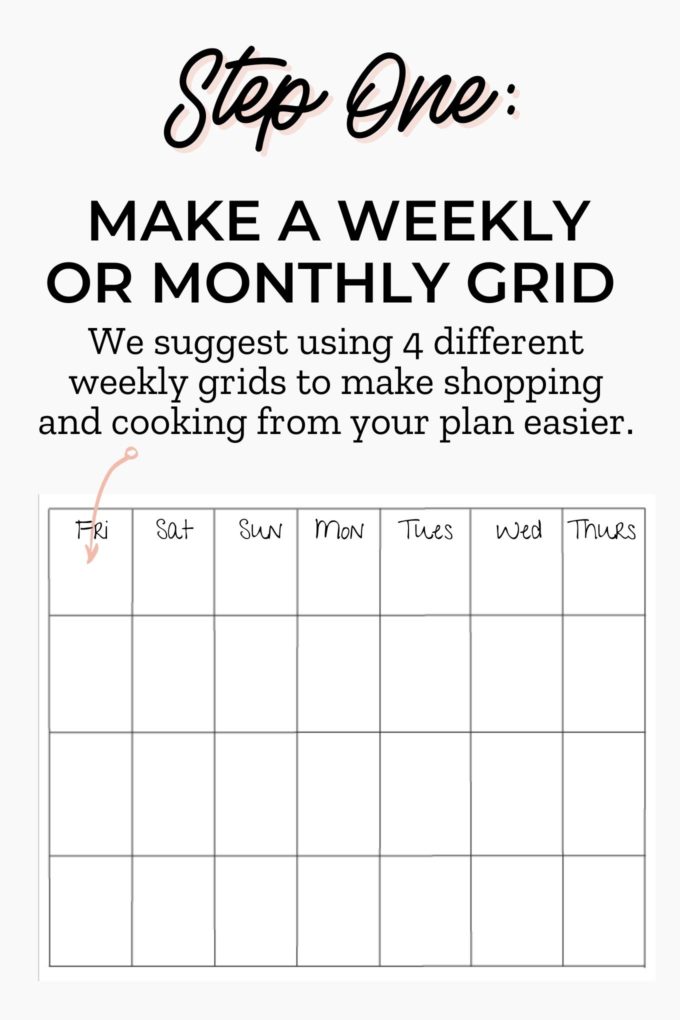
The first step to creating a meal plan for the entire month is the print off a calendar to write down all of your meals. Alternatively you can also draw out a calendar on a piece of paper.
Should you create a monthly calendar for your meal plan?
Though you’re planning for the entire month, I do not suggest putting all meals onto one monthly sheet. This is because you’ll want more space to include all ingredients needed for each meal to refer back to when cooking each night.
Instead, print out 4 weekly meal plans and then plan them together as a batch so you can have room to create your list directly on your week’s meal plan.
👉 Pro tip: Use a pencil to create your meal plan, not a pen! You will likely rearrange things once you get a birds-eye view of your meals for the month, so use pencil to sketch out your general meals so you can easily erase and switch meals around.
2️⃣ Step Two: Review your schedule before creating the meal plan
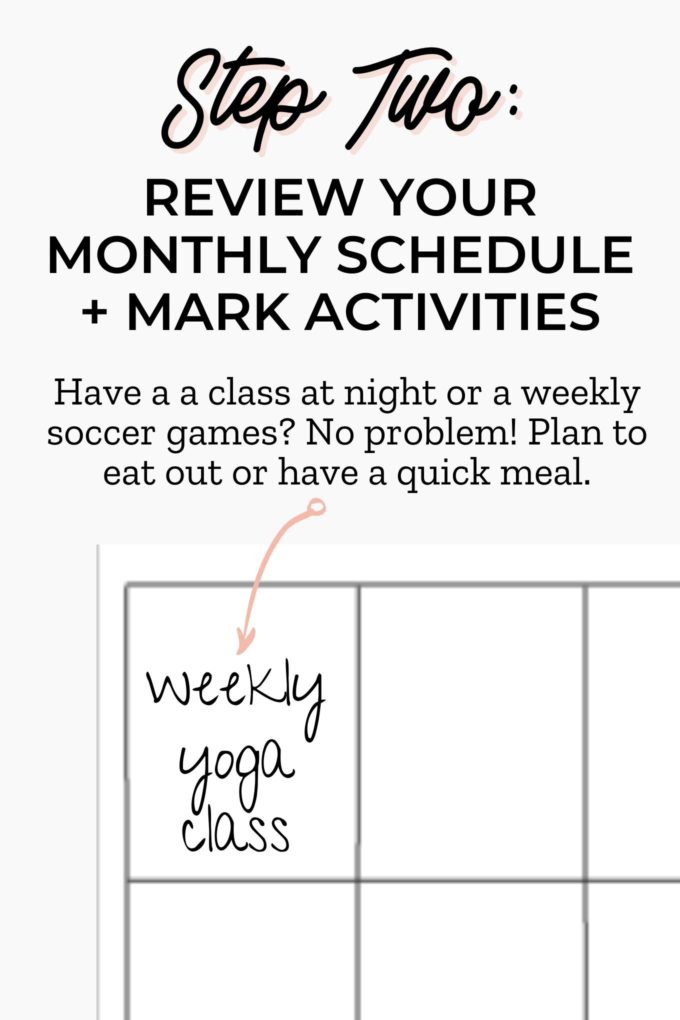
Before you start meal planning for a month, take a look at your monthly calendar and review your schedule.
What nights will be the easiest to meal plan? Which days of the week do you have family activities or appointments that might make cooking at home more difficult? Take note of these things before meal planning so that you can jot down certain nights when you’ll get takeout or nights when you will need an easier meal if you have something on the calendar.
Keep in mind that plans change and activities pop up, so be flexible and know that what you plan is not set in stone (that’s why we’re using a pencil!).
3️⃣ Step Three: Shop your pantry and refrigerator to see what food you already have on hand
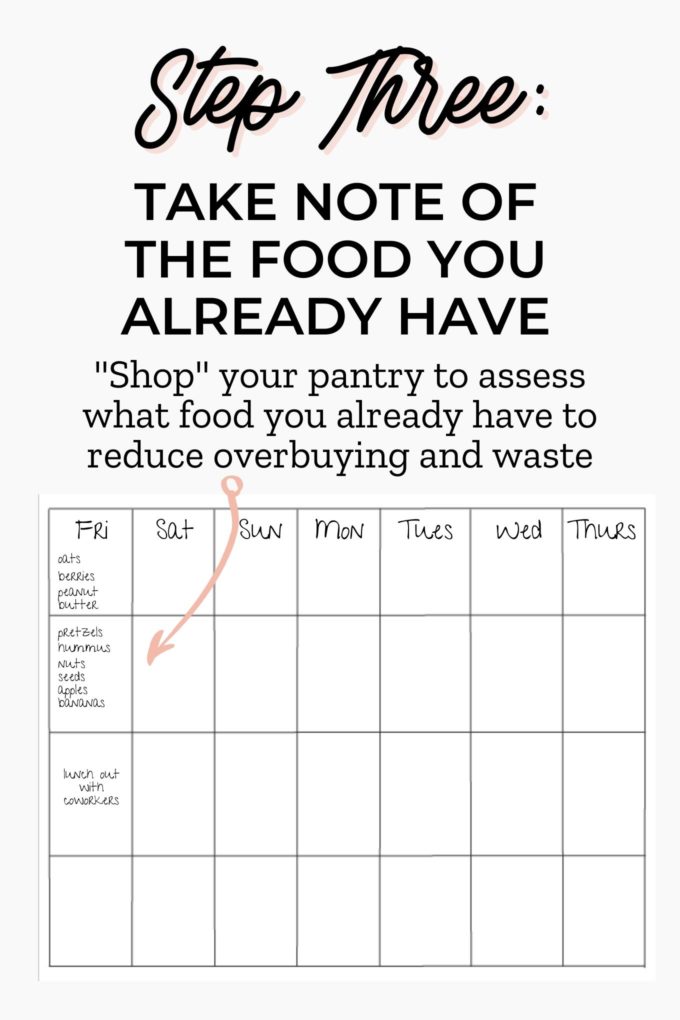
Before creating any specific meals, first take stock of what food you already have in your pantry and refrigerator.
Knowing what you already have in the house will help you in two ways:
- You can create meals from the items your already have
- As you’re building a list from the meals you plan, you can cross off the ingredients you already have
Taking an inventory of the food you have will help you to reduce food waste by making sure what you already have gets used, and will help you eliminate buying ingredients you already have on hand (so you don’t end up with three jars of cinnamon at once).
4️⃣ Step Four: List out each day’s meal and the ingredients needed
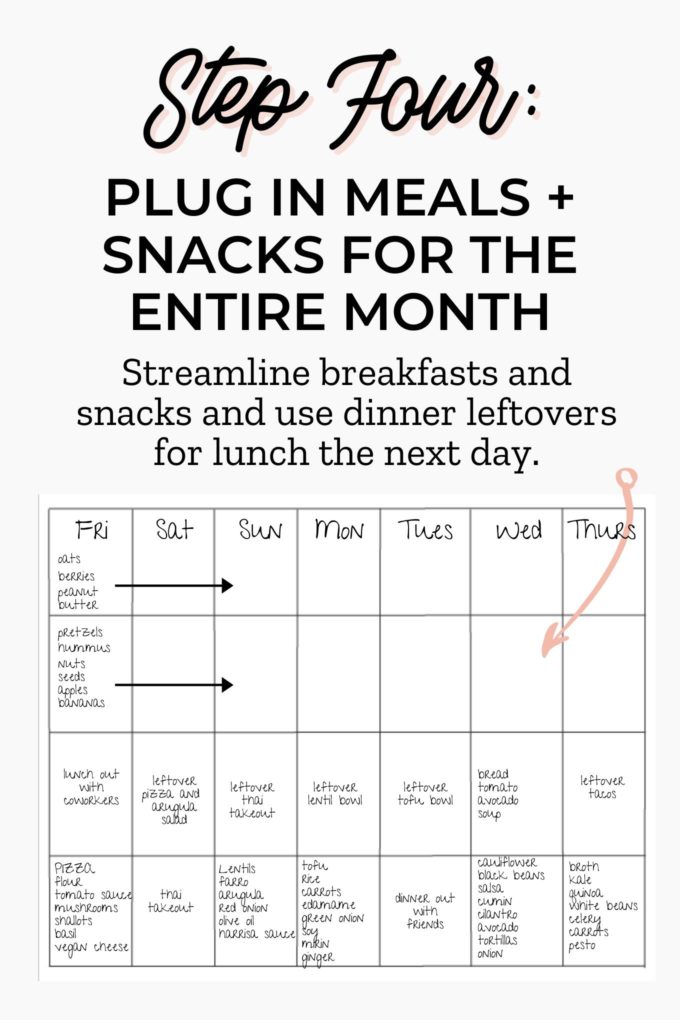
Next it’s time to list out the meals you’ll have each night on your meal planning calendar.
Here’s how to organize your meal plan:
- Write out the name of the meal you’ll have
- List the ingredients you’ll need for the meal under the meal name
- Cross off any ingredients you already have on hand
Planning out your meals and listing your ingredients does two things:
- It automatically creates a shopping list for you right on your meal plan
- It reminds you which ingredients you need each day when you cook
5️⃣ Step Five: Shop and cook from your list
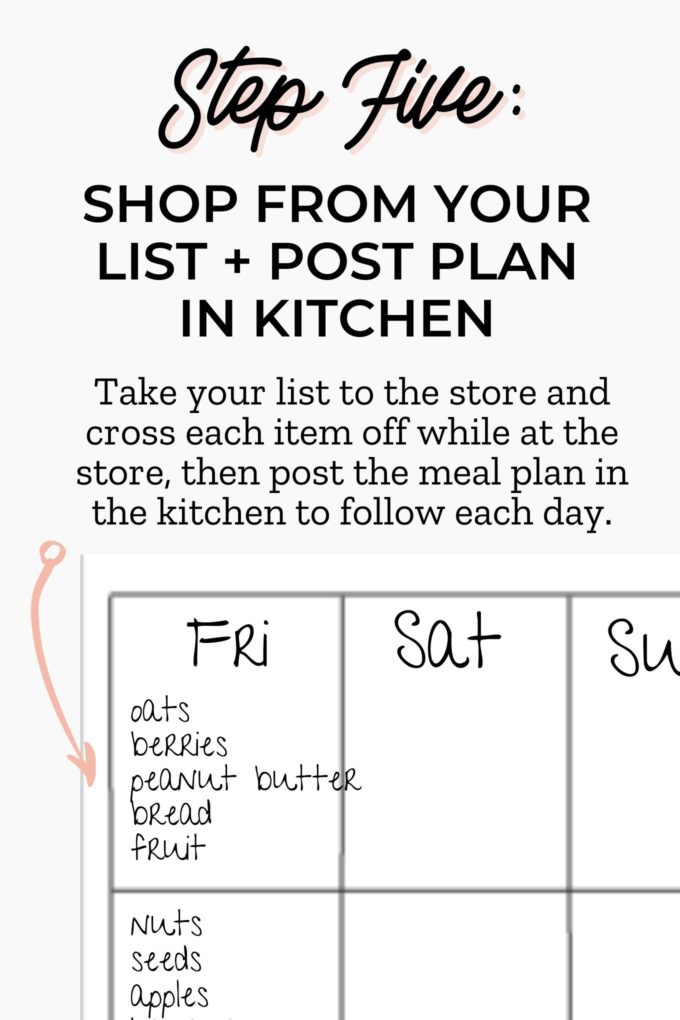
Once your meal plan is filled out with all ingredients, it’s time to shop! Simply take your meal plan with you to the store and cross off the ingredients as you put them into your cart. Then you’ll know that any ingredients that aren’t crossed off are still items you need to purchase.
👍 Tips for streamlining your monthly meal plan
🍝 Choose themed nights to have specific meals (pizza night, pasta night, salad night)
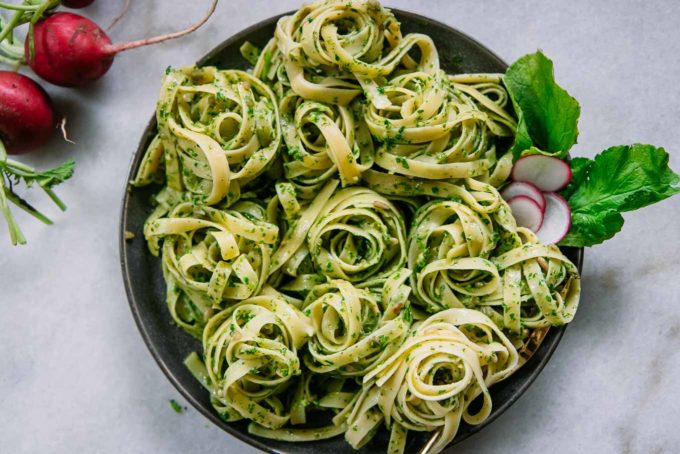
One of the simplest ways to get your meal plan started is to have themed nights each week, like Taco Tuesday, Pasta Wednesday, or Pizza Friday.
Having a night when you eat a certain type of food will make it easy for you to plan out meals each week. If you know you have homemade pizza every Friday evening then all you have to do is decide what type of pizza you’ll eat at the end of each week.
Themed meal nights are an excellent way to streamline your week and reduce decision fatigue – but they also help you to dig in an explore certain types of food by making them over and over each week.
🍎 Look up grocery sales and consider what fruits and vegetables are in season

One of the perks to meal planning is that you can save money by buying sale items and in-season produce each week (or month).
For example, if there’s a big sale on your favorite protein this week, buy it and plan meals around that ingredient so you can take advantage of the overall price reduction. Or if it’s summertime and tomatoes are in-season, meal plan your week so that you can cook with fresh tomatoes for a meal or two!
Even just meal planning to eat what’s on sale will help you save money. Take a look at the grocery ads each week and choose one meal that you’ll prepare using something from the sale section. This will help you save money and spend less at the grocery store, and help you get creative in the kitchen!
🥥 Make multiple meals from specialty ingredients

Have a meal that calls for a special ingredient that you don’t normally cook with? Use it in multiple meals to make sure it doesn’t go to waste!
For example, maybe you have a meal that calls for one cup of an ingredient like fresh basil. Instead of making the meal once and letting the leftover basil go to waste, put the remaining half cup in another meal this week.
🥙 Streamline meals and embrace leftovers

Stop to consider how you and/or your family typically eats: is dinner or lunch your biggest meal of the day? Are breakfasts usually quick and easy, or a more elaborate affair? The meals that aren’t your most important eating time can easily be streamlined throughout the week.
For example, in our house dinner is the meal we all sit down and eat together. Breakfast is usually quick and takes no more than ten minutes to make. For this reason, we usually eat the same one or two breakfasts each day to save time and make it an easy, quick endeavor instead of a big hassle when we’re trying to get out the door each morning.
Leftovers are also key to streamlining our daily meals. We make enough dinner each night to have ample leftovers for lunch the next day. This eliminates having to make lunch for work or school the next day because we simply save our dinner leftovers so there is enough for both meals.
🥬 Plan to use produce that will go bad first and save shelf stable and frozen for later in the month

One of the problems with planning your meals for an entire month at once – and then grocery shopping only one time – is that your fresh fruits and vegetables will likely go bad before you return to the store.
What do you do in weeks three and four of your monthly plan? You intentionally plan for it! Here’s how:
- Plan to use fresh fruits and vegetables that will go bad quickly (leafy greens, mushrooms, etc.) in the first week of your monthly plan
- Eat longer-lasting, but still perishable, produce in weeks two and three (broccoli, cauliflower, etc.)
- Save shelf-stable produce for week 4 of your plan (potatoes, beans, etc.)
🌮 Review the meal plan to make sure you have a variety of meals

Another problem with meal planning for a month at a time is that the meal plan turns into several days of eating the same meal.
To avoid this, make sure you have a variety of meals each week by using different cooking methods (i.e. grill, bake, saute), using different ingredients to prepare each meal (i.e. spaghetti with red sauce, spaghetti with whine sauce), and including meal ideas that make each meal different (i.e. add a side of risotto to your usual grilling night).
By spending a few minutes to review what each week’s menu will be, you’ll be able to spot meals that may not work well day-after-day and spread out different ingredients and meal types to keep your plan fresh each week.
🤔 Be flexible – and be prepared to move meals when life gets in the way

This is perhaps the most important step of meal planning for a month at a time: life often gets in the way of meal preparation, so being able to move your meal plan without stress is crucial.
Sometimes something come up last minute that may derail your planned meal, and that’s ok. Go into each week knowing that at least one of your meals will likely get bumped to another night, and that the beauty of shopping for a month at a time is that you have a lot of options at once.
Remember: meal planning doesn’t have to be difficult, and meal planning for a month at a time can make your meal routine much easier. Keep these tips in mind and meal planning will become quick and easy – no matter how busy you (or life) may become!
💡 More meal planning ideas and tips
Meal planning can seem daunting, but it doesn’t have to be! By following these simple steps, you can meal plan for an entire month in just a few hours. This will help reduce food waste, save money and time, and make meal preparation easier than ever.
Check out our other tips for making meal plans:

